On the fifth day of creation, three kinds of creatures are made: winged birds, creatures that swarm the sea, and the “great monsters.” These creatures are then grouped together with the land animals that were made on the sixth day (because it’s not until that day that “God saw that it was good”), among which are the ground creepers, cattle, and beasts of the earth. In total, six categories of animals are created:
Birds
Fish
Great monsters
Beasts of the earth
Cattle
Ground creepers
When God gave mankind dominion over the animal kingdom, only five of these six categories were mentioned. Man is said to rule over the fish, birds, beasts, ground creepers, and livestock (Gen 1:26). In his book, Creation in Six Days, the theologian James Jordan points out that one category is missing from this list, namely, the great monsters, implying that perhaps man does or did not have dominion over these creatures. Indeed, there are two textual clues that genuinely seem to point in the direction of “monsters” being a unique category of creatures.
First, the Hebrew word that gets translated as “monsters,” הַתַּנִּינִ֖ם, in Genesis 1:21 is often translated as “dragons” elsewhere in Scripture, and these dragons seem to be consistently depicted as serpentine creatures who lived either in the sea or on land (cf. Ex 7:9-10; Isa 43:20; Jer 9:11). Second, the Hebrew word for “create,” בָּרָ֣א, which is a word that only ever has God as its subject, is only used three times in Genesis 1: when God creates heaven and earth, when He creates man, and when He creates the great monsters. This implies that these monsters, like man, are a special and wondrous facet of God’s creation.
Now, if you’re still thinking that this apparent fifth day distinction between “great monsters” and “fish” is non-existent, consider Psalm 104. As Jordan demonstrates in Appendix E of his book (which I’ve reproduced below), this Psalm thematically unfolds the creation week day by day. Significantly, the section that corresponds to the fifth day is Psalm 104:24-26, which makes a distinction between the creatures that “swarm” in the “sea,” and “the Leviathan” whom God made to play in the waters. Regardless of your personal views of Genesis 1, this demonstrates that later biblical authors indeed noted a distinction between “fish” and “monsters” on the fifth day of creation.1 This strongly suggests that we shouldn’t ignore the fact that monsters seem to be left out of the “dominion mandate” of Genesis 1:26. Rather, we should seek a robust biblical explanation for this seemingly odd detail, which I believe we can begin to uncover by looking at the book of Job.
As I’ve shown before,2 the sequence of God’s speeches in Job 38-41 intentionally calls us back to early Genesis. To recap, Job is portrayed as a new Adam. He is “the greatest of all the peoples of the East” (Job 1:3), just as Adam was the exalted one in the Garden that was planted “in the East” (Gen 2:8). Like Adam, Job was tempted by his wife to “curse God and die” (Job 2:9), however, unlike Adam (Gen 3:17), Job didn’t listen. More substantially, consider what Adam witnesses in Genesis 2-3. The text suggests that the Garden was planted before his very eyes (Gen 2:7-8), meaning that the first thing Adam was shown was God’s creative power. After this, God brings the animals two by two to Adam, and he learns from the animals, discerning that since they each have a suitable helpmate, he needs one too (Gen 2:18-21). Finally, the last beast that Adam faces is the serpent who entices him and his wife to sin (Gen 3).
This is the exact sequence of events that happens in God’s speeches to Job. In Job 38, God takes Job on a literary tour of the creation, demonstrating His creative power, just as He had done to Adam. After this, in Job 39, God walks Job through the animal kingdom, teaching him wisdom through all the glorious creatures He has made (cf. Job 12:7). Finally, in Job 40-41, just as the final beast Adam faced was the serpent, so too are the final beasts shown to Job the “Behemoth” and “Leviathan,” both of whom God uses to work His good purposes in the world, just as He was doing in Eden.
Although Behemoth and Leviathan are clearly being presented as images of the serpent from Genesis 3 and the Satan from Job 1-2 (cf. Job 41:34, “he is king over all the sons of pride”), they are nonetheless described as real creatures. Just as real creatures are used as meaningful symbols of Israel’s tribes (Gen 49:9; Deut 33:17), and even God Himself (Isa 31:4; Rev. 5:5), so too are real creatures presented as images of the demonic in Genesis 3 and Job 40-41. This is no different than Revelation 18:3 using “unclean birds” as a symbol for “unclean spirits.” Just because the former is symbolic of the latter, doesn’t mean that eagles, ravens, and vultures aren’t real.
That Behemoth and Leviathan are intended to be real creatures, as opposed to mythical ones, is further confirmed when we consider what we already know about them. Not only are both of these beasts connected to the serpent of Genesis 3 (who was “more crafty than any other beast of the field that the Lord God had made”), but also recall Psalm 104. This Psalm directly identifies Leviathan as one of the “great monsters” from the fifth day of creation, which tells us that Leviathan, like other animals made on the fifth day, is a real creature. Ezekiel 29:2-6 likewise connects the הַתַּנִּינִ֖ם of Genesis 1:21 to both Behemoth and Leviathan by describing Pharaoh as the “monster” in whose “jaws” God puts “hooks” (cf. Job 40:24; 41:2). Unless we want to posit some arbitrary distinction between “real” and “mythical” animals in Genesis 1, which the biblical authors give no indication of recognizing, we must take the descriptions of Behemoth and Leviathan as pertaining to real creatures. With this in mind, let’s take a look at these descriptions.
Starting with Behemoth, if he’s a real creature, then the conventional explanation is that he’s probably something like an elephant or a hippo. Perhaps this makes sense of him “eating grass” (Job 40:15), his bones being like “bronze,” and his limbs like “iron bars” (Job 40:18), however it doesn’t explain how Behemoth “moves his tail like a cedar” (Job 40:17). As we all know, elephants and hippos have relatively small tails, yet throughout Scripture, cedar trees are known for their “towering height” (Ezek 31:3-5), and immense size (cf. 1 Kg 6:6-36; 7:2; 2 Kg 19:23). If the sacred author of Job uses “cedar” to describe Behemoth’s tail, then this means that, whatever creature he is, he not only has massive limbs, but also a massive tail. This makes it much easier to imagine Behemoth as a dinosaur like Apatosaurus or Diplodocus, than as an elephant, hippo, or any other modern creature.
Next we have Leviathan. Although it’s common to think that he’s really just a crocodile, this doesn’t work for several reasons. Not only does Leviathan breathe fire (Job 41:18-20), but something his description really emphasizes is that he cannot be killed with weapons: “Though the sword reaches him, it does not avail, nor the spear, the dart, or the javelin… The arrow cannot make him flee… Clubs are counted as stubble; he laughs at the rattle of javelin” (Job 41:26-29). This stands in contrast to crocodiles, which we know were killed for sport by the thousands in the Ancient Near East,3 oftentimes with clubs and spears. If we eliminate crocodiles and the like from our list of candidates, we really aren’t left with any modern options that fit Leviathan’s description. Instead, creatures who have “mighty strength” (Job 41:12), “terrifying teeth” (Job 41:14), “rows of scales” (Job 41:15), and are impervious to ancient weaponry, seem much more identifiable among dinosaurs like the mosasaur.
Indeed, Behemoth and Leviathan being “unconquerable” beasts is the main theological point behind their description.4 The answer to the debate between Job and his friends regarding theodicy is that it’s God who “pierces” Behemoth and Leviathan and leads them around with a hook (Job 40:24; 41:1-2). It’s He who providentially guides the work of Satan in the world for His own ends. Whereas mankind has no power to control these beasts, God does. Behemoth and Leviathan, as great monsters or dinosaurs, were the perfect image of this because these were the creatures that mankind wasn’t given explicit dominion over in Genesis 1. These were the creatures that ancient man ran away from in fear (cf. Job 41:33), because unlike all other beasts, he had no ability to subdue these ones.
However, Job’s story doesn’t end here. The overall point God makes about “the problem of evil” isn’t that He allows evil merely because His ways are inscrutable; rather it’s that suffering is always designed to bring about the glorification of His servants. Whereas Job 1-2 opens with Job being left out of the divine council’s deliberations, Job 42 shows us that, through his suffering, Job has grown in wisdom and been exalted to this very council. We know this because after God’s speeches Job is told to “intercede” for his friends, which is something prophets were able to do under the old covenant due to their incorporation into the divine council.5
Like Adam was always destined to,6 Job learned true wisdom and was able to reign with God in Heaven. This makes sense of why God blessed Job by doubling the number of his animals to be 22,000 in total (Job 42:12). Job’s animals bearing the number of letters in the Hebrew alphabet symbolizes the fact that, through his death and resurrection, Job has become an exalted Adam. He now has dominion over everything from A-Z, including the great monsters. The implication seems to be, while mankind originally didn’t have dominion over the great dinosaurs, he eventually would.
If there’s any doubt, consider something else the great monsters symbolize in Scripture: the Gentile nations. Just as mankind didn’t have dominion over the dinosaurs, so too did Israel not have dominion over the nations. We see this in Daniel 7:1-28 when four “beasts” rise up “out of the sea,” reminding us of Leviathan, and these four beasts are the four Gentile nations who are going to be ruling over Israel, not the other way around, in the days leading up to Christ. Likewise, as mentioned above, Ezekiel 29:2-6 explicitly calls Pharaoh, the Gentile ruler of Egypt, a “monster,” הַתַּנִּינִ֖ם, and connects him to Job’s description of Behemoth and Leviathan. Going back to the exodus itself, Israel would have remembered that Egypt, the land of serpents (cf. Ex 4:2-4; 7:9-12), was a beast that the Lord alone tamed on their behalf (Ex 20:2).
However, while it’s true that Israel didn’t have dominion over the nations, she was always destined to. All nations bowing at the feet of Israel is one of the prophets’ greatest hopes (Isa 60:12-14; Dan 7:13-27), going back to the patriarchs themselves (Gen 49:8). The fulfillment of this takes place in Israel’s Christ, the one to whom all nations are subject (cf. 1 Cor 15:21-28; Rev 7:9). It’s in Him that humanity is finally “crowned with glory and honor” (Heb 2:9), given “authority over unclean spirits” (Mk 6:7), and told to “judge” even “the angels” (1 Cor 6:3).
The point I’m making is that, throughout Scripture, monsters or dinosaurs are real creatures that consistently represent that which man temporarily didn’t have dominion over, but has since come to have dominion over in Christ. Moreover, like many “golden threads” in Scripture, this one too goes back to the opening lines of Genesis, “So God created the great monsters” (Gen 1:21), and culminates at the end of Revelation, “And the great dragon was thrown down, that ancient serpent, who is called the devil and Satan, the deceiver of the whole world” (Rev 12:7-9). This perhaps sheds new light on stories about dragon-slaying Saints like Ss. Philip, George, and Theodore.7 Men being able to conquer the “great monsters” is a concrete sign of Christ’s victory over the demonic powers these creatures represent.
However, I don’t want to end with the impression that dinosaurs are intrinsically evil creatures. It’s true that the fall of man corrupted them and made them ferocious beasts who could truly symbolize the demonic, however, it wasn’t always this way. Like everything else made on the fifth day, the dinosaurs were originally declared to be “good” (Gen 1:21). As mentioned before, they were one of the few creatures whom God specially “created” during the creation week, showing them to be a unique and wondrous part of this good creation (why else would children’s minds be so often captivated by these glorious beasts). Thus, it’s my speculation that, if even the ferocious lions, bears, and wolves shall lie down with the lambs, calves, and goats (Isa 11:6-7), then we shouldn’t be surprised to see dinosaurs in the world to come. Maybe even someday before that time, God will re-establish the dinosaurs on earth and give man the ability to have a peaceful dominion over them. Maybe.
The Creation Week in Psalm 104
Day 1: The creation of light.
Bless the Lord, O my soul! O Lord my God, you are very great! You are clothed with splendor and majesty, covering yourself with light as with a garment, stretching out the heavens like a tent.
Psalm 104:1-2
Day 2: Separation of heaven and earth, waters above and waters below.
He lays the beams of his chambers on the waters; he makes the clouds his chariot; he rides on the wings of the wind; he makes his messengers spirits, his ministers a flaming fire. He set the earth on its foundations, so that it should never be moved. You covered it with the deep as with a garment; the waters stood above the mountains. At your rebuke they fled; at the sound of your thunder they took to flight. The mountains rose, the valleys sank down to the place that you appointed for them. You set a boundary that they may not pass, so that they might not again cover the earth. You make springs gush forth in the valleys; they flow between the hills; they give drink to every beast of the field; the wild donkeys quench their thirst. Beside them the birds of the heavens dwell; they sing among the branches. From your lofty abode you water the mountains; the earth is satisfied with the fruit of your work.
Psalm 104:3-13
Day 3: The creation of grain plants and fruit trees.
You cause the grass to grow for the livestock and plants for man to cultivate, that he may bring forth food from the earth and wine to gladden the heart of man, oil to make his face shine and bread to strengthen man’s heart. The trees of the Lord are watered abundantly, the cedars of Lebanon that he planted. In them the birds build their nests; the stork has her home in the fir trees. The high mountains are for the wild goats; the rocks are a refuge for the rock badgers.
Psalm 104:14-18
Day 4: The creation of the sun, moon, and stars.
He made the moon to mark the seasons; the sun knows its time for setting. You make darkness, and it is night, when all the beasts of the forest creep about. The young lions roar for their prey, seeking their food from God. When the sun rises, they steal away and lie down in their dens. Man goes out to his work and to his labor until the evening.
Psalm 104:19-23
Day 5: The creation of creatures that swarm in the sea and the great monsters.
O Lord, how manifold are your works! In wisdom have you made them all; the earth is full of your creatures. Here is the sea, great and wide, which teems with creatures innumerable, living things both small and great. There go the ships, and Leviathan, which you formed to play in it.
Psalm 104:24-26
Day 6: The creation of the animals and man, both are made out of the ground, Adam is filled with the Spirit.
These all look to you, to give them their food in due season. When you give it to them, they gather it up; when you open your hand, they are filled with good things. When you hide your face, they are dismayed; when you take away their breath, they die and return to their dust. When you send forth your Spirit, they are created, and you renew the face of the ground.
Psalm 104:27-30
Day 7: The Sabbath Day of Judgement.
May the glory of the Lord endure forever; may the Lord rejoice in his works, who looks on the earth and it trembles, who touches the mountains and they smoke! I will sing to the Lord as long as I live; I will sing praise to my God while I have being. May my meditation be pleasing to him, for I rejoice in the Lord. Let sinners be consumed from the earth, and let the wicked be no more! Bless the Lord, O my soul! Praise the Lord!
Psalm 104:31-35
It’s worth noting that later Jewish tradition picked up on the Leviathan’s association with the fifth day of creation as well. See the New World Encyclopedia, “Leviathan.”
See my articles, “Why the Leviathan is Satan,” and, “The Satan and the Serpent.”
See Meilan Solly, “Ancient Egyptians Hunted, Then Mummified, Crocodiles.”
Once again, see my article, “The Satan and the Serpent.”
For more on this, see Seraphim Hamilton, “A Biblical Theology of the Invocation of Saints.”
See my article, “What Happened in the Garden?.”
See Philip Kosloski, “These saints were professional dragon-slayers.”

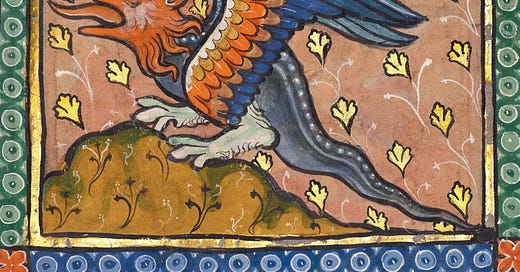



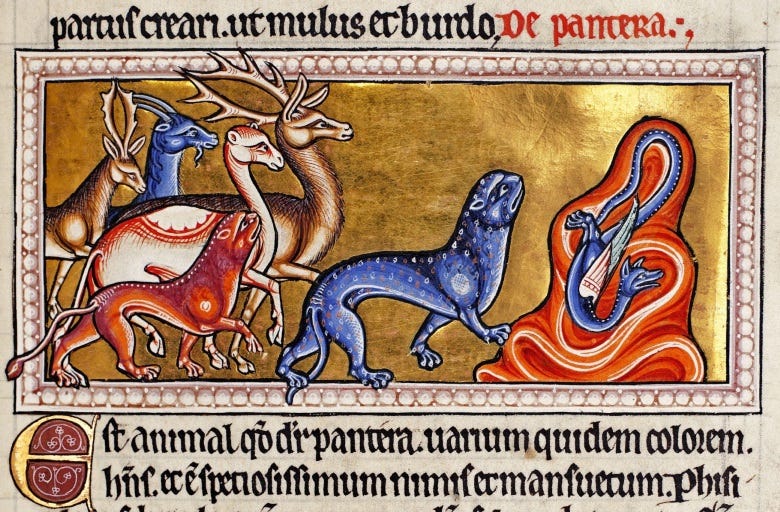
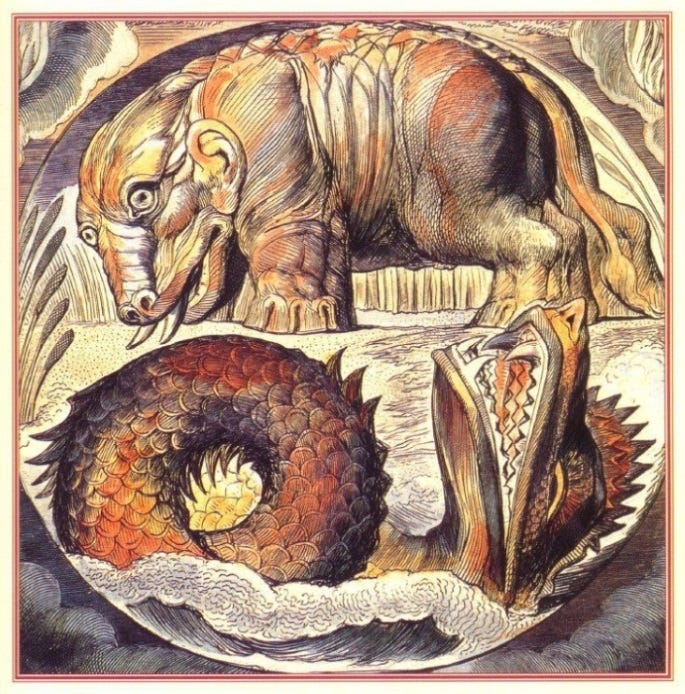
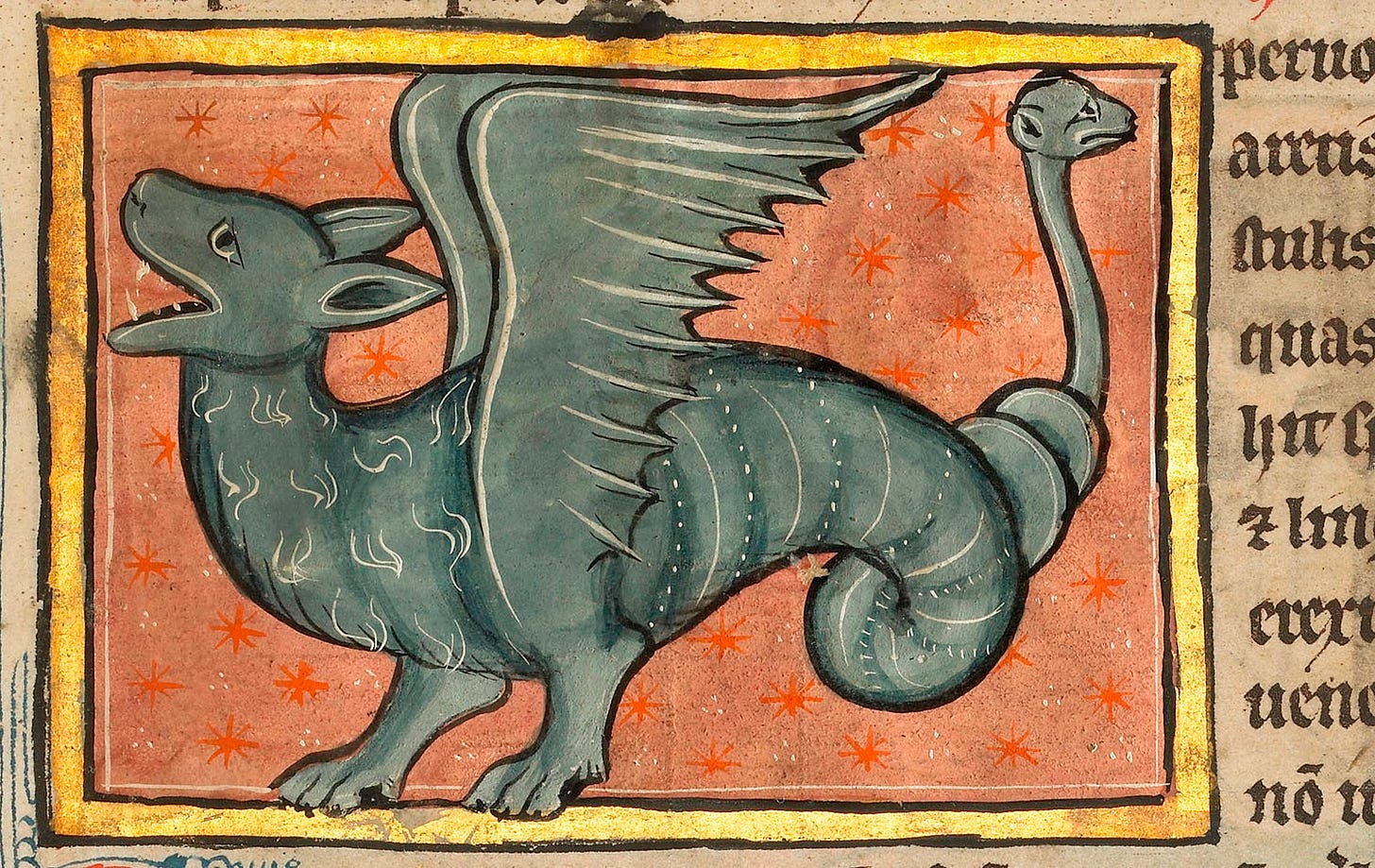
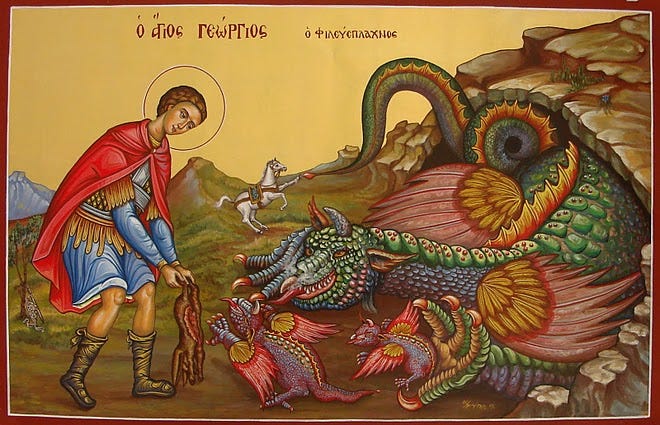
Excellent work
What I find strange is that these monsters almost certainly were extinct before Job's time whether you're an OEC who believes they died before the creation of man or a YEC who believes they died in the Noahic flood, since Job is an Edomite. Yet, he is somehow supposed to be familiar with them.